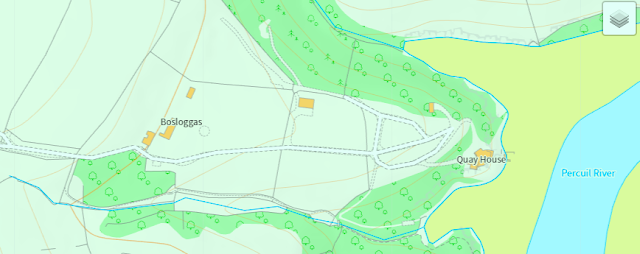De Sadorn, seythves warn ügens mis Ebrel
Saturday, 27th April
E'n tavas Kernowek ma lies hanow plurel cuntellek. Rag fra? Martesen, Kernow o overdevys gen lies plans, plansow na alja bos reknys. Martesen thera bestes münys heb nòmber dhe vos comptys ow hesya dres an pow. Nei ell gwil hanow üdnek gen "-en" war lost an ger cuntellek. Ma henwyn teleryow gen plansow ha bestes a vry ettans. En 1327 thera tüs trigys en Boslogos, gen lies logojen martesen. A wrüg logos dos dhort an ryvar po an coos? A wrüg anjei debry oll aga ys?
In the Cornish language there are many collective plural nouns. Why? Perhaps, Cornwall was overgrown with many plants, plants that could not be counted. Perhaps countless little animals were swarming all over the country. We can make a singular noun with "-en" on the tail of the collective word. There are place names with significant plants and animals in them. In 1327 there were people living in a "dwelling of mice", with lots of mice perhaps. Did mice come from the river or the wood? Did they eat all their corn?
Deg ger rag hedhyw Ten words for today
a vry significant
cuntellek collective
dres an pow all over the country
grevos troublesome
heb nòmber dhe vos comptys countless
hesa ~ hesya to swarm
logojen (f) mouse < pl. logos > Boslogos > Bosloggas PN (SWFM logosen)
overdevys overgrown < tevy to grow
reknys counted < rekna to count
üdnek singular, single, lone, individual, etc.
Otta teleryow moy gen creaturs grevos.
Here are some more places with troublesome creatures.
- gohy wasps > sing. gohien > Tregiffian (St Buryan) was in1331 Tregguhion > Treguhyon = wasp-infested farm (ha trigva an scrifer John Le Carré)
- whil beetle Trewhella was in 1357 Trewyla > Trewhila = beetle-infested farm
- gwibes gnats > sing. gwibesen or whibys gnats > sing. whiben > Lawhippet was in 1592 Lawhybbet > Nant Wibed (OC) = valley of gnats
- mòryon ants > sing. mòryonen > Mornick was in 1601 Morinicke > Moryonek = ant-infested



No comments:
Post a Comment